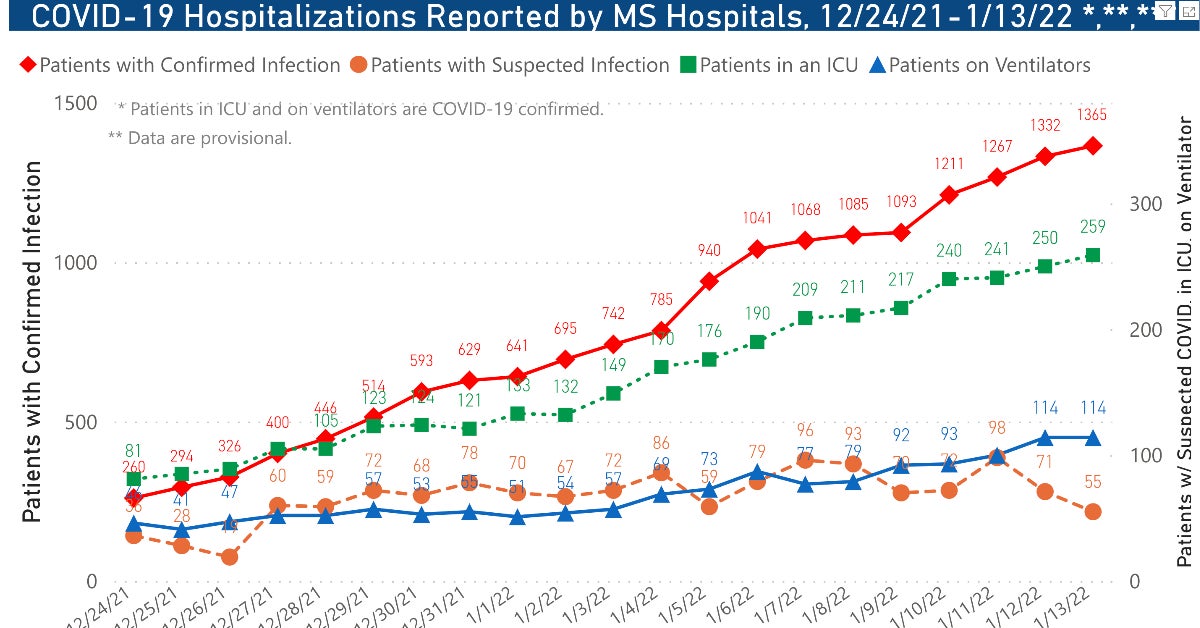Edney: Staffing shortages the latest COVID-19 obstacle
Published 2:32 pm Friday, January 14, 2022

- Hospitalizations in Mississippi have steadily risen as the Omicron variant of COVID-19 hit the state. (MSDH Graphic)
The highly contagious Omicron variant of COVID-19 has infected thousands in Mississippi, and hospitals are feeling the effects.
On Tuesday, the Mississippi State Department of Health issued a statewide order mandating that all licensed hospitals participate in the Mississippi COVID System of Care Plan.
This order puts in place a system by which all tertiary care hospitals (major/specialty hospitals) are required to accept the same number of transfers, local physician and chief medical officer for MSDH Dr. Dan Edney said.
The transfers would not just be COVID-19 patients, Edney said; it would also include trauma, heart attack and stroke patients.
“If you have a brain bleed in Vicksburg and need to be transferred to a hospital with a neurosurgeon, this system requires an appropriate hospital to accept you in transfer,” Edney said.
Also on Tuesday, the University of Mississippi Medical Center held a press conference. Dr. Louann Woodward, the vice chancellor for the health affairs and dean of the school of medicine at UMMC, announced the hospital would be receiving federal assistance in the form of staffing.
A field hospital will also be deployed.
Woodard said, although UMMC does have adult med surge and ICU beds available, they are not able to use them due to staffing issues.
“Through informal conversations with my friends around the state, there are a number of hospitals in that same position,” Woodward said.
Edney said the state is down more than 2,000 nurses statewide from pre-COVID levels, and this is not just affecting the hospitals.
The large number of people infected with Omicron is also taking its toll on outpatient clinic treatment — all during flu and pneumonia season, when clinics and hospitals are busier than usual, he said.
Additionally, cold and flu season is making it challenging for one to determine if they have COVID-19.
“Cold and sinus symptoms are most likely not COVID,” Edney said. “But currently, about 20 percent of these cases are covid. The only way to know for sure is through testing.”
If one does test positive for COVID-19, Edney said, it is important to let your physician know so he or she can monitor you through your isolation period in case you were to get worse.
“The most worrisome symptoms for us are for a patient to develop shortness of breath and low oxygen levels,” Edney said, adding that Omicron is predominately an upper respiratory illness, but some people are still developing COVID pneumonia.
Children who contract Omicron generally have mild symptoms. But Edney said there are those who can develop MIS-C, which is an inflammatory reaction to the infection that can cause organ failure or significant myocarditis and pneumonia.
With testing being the only measure to diagnosis if one has COVID-19, getting tested has also become a challenge.
At-home COVID-19 test kits are in short supply locally, and clinic wait times are climbing. These obstacles have made it difficult for employees whose employers are requiring a negative test to return to work.
“The MSDH advises against employers requiring a negative test for return to work,” Edney said. “The test may remain positive long past the time of infectiousness and is a wasted resource. We don’t have the capacity to test everyone for things like this.
“Return to work is a medical decision and should be made by the professional treating the patient. Our clinic will not perform testing for this reason and is basically only testing patients who have symptoms, but we are happy to provide return to work statements documenting fitness for duty.”
When asked if a downward trend in COVID cases is near, Edney said, “We are hopeful that Omicron will increase community immunity at a rate higher than we’ve seen thus far. We’re hoping community transmission will greatly drop off IF we aren’t faced with more mutations-possibly late February.”
Therefore, while the virus is still infecting, Edney said, being vaccinated and boosted is our best “tool” against COVID, which is evidenced by the numbers.
“Seventy-four percent of current deaths are among unvaccinated, 24 percent are among vaccinated, but not boosted as needed, and only 2 percent among fully vaccinated and boosted,” he said.
While there is reason to be concerned about the surge and the serious situation hospitals are facing, Edney said, it is not time to panic.
“Everyone can help this situation by getting vaccinated/boosted and wearing masks in high-risk indoor situations. Whatever we can do to reduce the amount of community transmission is helpful,” he said.






